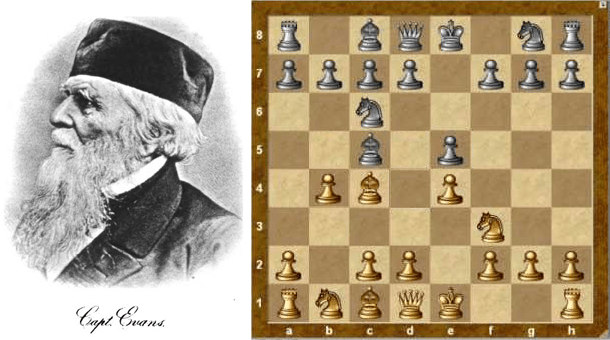
Old Sailor's Gambit
William Davies Evans, the author of the famous Evans Gambit, was born on the Welsh farm of Musland, parish of St. Dogwells, county Pembrokeshire. At the age of 14 he was enlisted in the Navy, having managed to take part in the military actions of Great Britain in the Neapolitan War of 1815. He was then transferred to the postal department, and in 1819 had reached the rank of сaptain of the postal packet boat. So his entire working life was in the service of the British Government Mail until he retired for health reasons in 1840.
In 1824, being the captain of a steam postal packet, when actually at sea between Milford in Wales and Dunmore (the port of Waterford) in Ireland, Evans devised the gambit which now bears his name. The original idea of the sacrifice of the "b" pawn came to William Evans when he analyzed the Giuoco Piano in Jacob Sarratt's "A Treatise on the Game of Chess". It is worth noting that originally Evans applied the gambit invented by him in a deferred form: 1. e4 e5 2. Nf3 Nc6 3. Bc4 Bc5 4. 0-0 d6 5. b4, while now Evans Gambit is understood as a move 4. b4 before castling.
The first time that the gambit was applied by its author at the official level, was a game played roughly between 1826 and 1827 (exact date unknown) in the London Subscription Rooms for Chess in St. Martin's Lane. Evans' opponent was the famous Irish chess master of the XIX century Alexander McDonnell.
Here is the full text of this letter:
"William Davies Evans is a native of Pembrokeshire, South Wales, and was born on the 27th of January, 1790. He commenced a naval career at the age of fourteen. He was about twenty-eight years of age when he first learnt the moves of the game of Chess. Having the advantage of frequent practice, with Lieut. H. Wilson, R.N., who was a player of some reputation in his time, beside corresponding on the subject of the game with the late Mr. W. Lewis, and also with Mr. George Walker, the able Chess Editor of "Bell's Life", he made a rapid progress in the game. Captain Evans received at first the odds of a Rook from Lieut. Wilson. After a continuance of play for some years, the odds were greatly reduced, until ultimately Captain Evans succeeded in defeating his formidable antagonist playing even.
About the year 1824, being then in command of a Government Mail Steamer, the passages between Milford Haven and Waterford were favorable to the study of the game of Chess, and at this time he invented the Gambit, which bears his name. The idea occurred to him while studying a variations of the Giuoco Piano in Sarratt's "A Treatise on the Game of Chess".
Captain Evans was the first who gave to the world a true solution of that very difficult end game, the King and three Pawns unmoved against King and three Pawns also unmoved. This position was handed down to us through a period of some centuries as a drawn game, but Captain Evans proved that the first player can always win.
Captain Evans acquired some celebrity as "Inventor of the System of Tri-coloured Lights for Ships to prevent Collisions at Night", which has been adopted by all nations possessing a marine. For this invention the English Government awarded him the sum of 1,500£ and the Czar of Russia a gold pocket chronometer, value 160£, together with a donation of 200£."
Organized thanks to a published letter the collection of funds, which allowed to collect more than 200 pounds, unfortunately was late. William Evans died on August 3rd, 1872, and was buried in the old city cemetery in Ostend. The following words are engraved on his tomb:
"To the sacred memory of William Davies Evans, formerly Commander in the Post Office and Peninsular and Oriental Steam Services; Superintendent in the Royal Mail Steam Company, and inventor of the system of tri-coloured light for shipping. Also well known in the Chess World as the author of the Evans Gambit."
***
David Bronstein very aptly said about the Evans Gambit:
"Evans Gambit is not an chess opening variation, it is a style of conducting a chess game. And those who want to successfully move forward along the lines of tournament success cannot get past these elements of chess strategy".
Below are several games played by the great chess masters of different eras. Only one thing unites all these games: White goes into the Evans Gambit with one's visor raised!
***
Mikhail Chigorin:
"Not yet born man who could prove conclusively with the positivity for whose benefit the Evans Gambit".
***
Bobby Fischer:
"Evans Gambit was analyzed along and across by the 90s of the last century, but also today it leads to an interesting struggle".
***
I would like to finish the chessgames selection by the world famous game of Adolf Anderssen, which went down in history of chess as "evergreen game":
***
Russian version of this article can be found here.

Previous articles:
